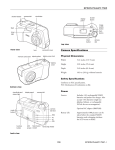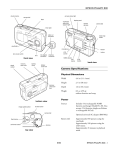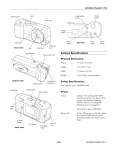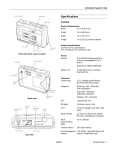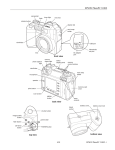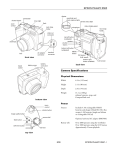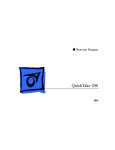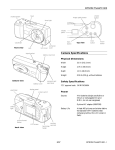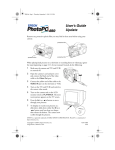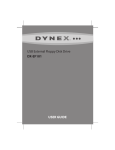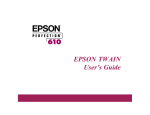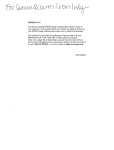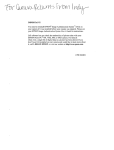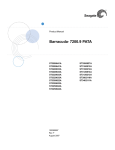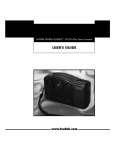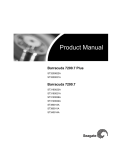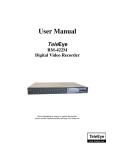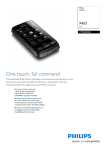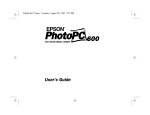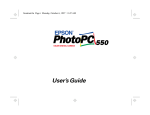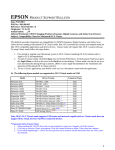Download Epson PhotoPC 650 Digital Camera Product Information Guide
Transcript
EPSON PhotoPC 650 status display panel viewfinder shutter button shutter button flash EPSON ON EPS EPS timer light flash button ON image quality button macro/timer button top view 37 mm threads for optional lenses lens lens cover (on/off) Camera Specifications card and port cover front view Physical Dimensions Width 5.3 inches (134.5 mm) Height 3.2 inches (81 mm) Depth 2.2 inches (57 mm) Weight 11.1 oz, ± 0.4 oz (315 g, ± 10 g), without batteries tripod threads Safety Specifications battery cover Conforms to FCC specifications. FCC Declaration of Conformity on file. CompactFlash card eject switch bottom view Power Sources status display panel LCD monitor switch status light viewfinder Includes 4 AA alkaline batteries. Also accepts lithium or rechargeable NiCad or NiMH batteries. Optional AC adapter (B867038) Optional rechargeable NiMH Power Pak with charger and four batteries; universal voltage (B818172) or 110 V (B818051) Environmental Temperature Operating: Storage: Function button Humidity (non-condensing) LCD monitor Operating: Storage: 32 to 104 °F (0 to 40 °C) –4 to 140 °F (–20 to 60 °C) 30 to 90% 30 to 90% back view 7/99 EPSON PhotoPC 650 - 1 EPSON PhotoPC 650 Technical Photographic Product type 1.09 megapixel CCD (charged coupled device), still frame, auto focus camera Image quality modes (pixels) Uncompressed JPEG: 1152 × 864 Superfine: 1152 × 864 (low compression) Fine: 1152 × 864 (medium compression) Standard: 640 × 480 (VGA) File format JPEG Color modes 16.7 million colors or 24-bit Lens type Five elements in four groups, aspherical glass lens Lens EPSON ClearOptics aspherical glass lens, 6 mm focal length (equivalent to a 39 mm lens on a 35 mm camera) Auto focus range 11.8 inches (0.3 m) to infinity 5.9 to 23.6 inches (15 to 60 cm) in macro mode LCD monitor 1.8-inch active matrix TFT color LCD; 280 × 220 resolution; 15 to 18 frames per second refresh rate; instant preview and playback modes Sensitivity Equivalent to ISO 140 Exposure control Program auto exposure CCD sensor 1/3 inch color area (1.09 megapixels) White balance Serial interface 1 pin RCA type (to camera); RS-232 9-pin (to Windows computer); 8-pin mini-DIN (to Macintosh) Full automatic TTL white balance through lens Shutter Electromechanical shutter, 1/4 second to 1/500 second speed Viewfinder Virtual, with edge border (80% accuracy) Aperture f2, f4, f 5.6, f 11 Flash modes Automatic, forced flash, red-eye reduction flash, or flash off Flash range 3.2 to 9.8 ft (1 to 3 m) Serial communication speed Up to 115.2Kbps (Windows) or 230.4Kbps (Macintosh) with high-speed serial port Storage type ATA-compatible CompactFlash cards; 8MB USB enabled CompactFlash card standard (described below) USB CompactFlash card 8MB flash memory Average picture storage capacity: Standard: 88 (640 × 480 pixels) Fine: 47 (1152 × 864 pixels) Superfine: 30 (1152 × 864 pixels) Uncompressed: 4 (1152 × 864 pixels) Optional expansion memory Video out Lexar Media JumpShot USB Cable Specifications USB enabled CompactFlash cards from 4MB to 64MB (available from Lexar Media) or ATA-compatible CompactFlash cards from 4MB to 80MB (available from Lexar Media or SanDisk) Interfaces CompactFlash Type I socket for USB CompactFlash card; USB type A connector for Windows® 98 PC, iMac,™ or Power Macintosh® G3 LED indicator Steady green when the USB CompactFlash card is recognized; flashing green during data transfer NTSC or PAL standard (user-selectable) Adapter dimensions Length: 3 inches (76 mm) Width: 1.5 inches (38 mm) Height: 0.7 inch (17.5 mm) Cable length 2 - EPSON PhotoPC 650 7/99 2.5 feet (0.8 meters) EPSON PhotoPC 650 If you want to increase your camera’s picture storage capacity or keep an extra CompactFlash card on hand, you can install these types of CompactFlash cards in your camera: Optional AC Adapter Specifications Physical Dimensions ❏ New USB Enabled CompactFlash cards, or Width 1.97 inches (50 mm) ❏ Traditional ATA-compatible CompactFlash cards Height 1.18 inches (30 mm) 1.85 inches (47 mm) including pins Depth 3.74 inches (95 mm) If you transfer pictures via the Lexar Media JumpShot USB cable, you can purchase additional USB Enabled CompactFlash cards from Lexar Media. Your camera comes with an 8MB USB CompactFlash card, but you can obtain a higher capacity card, such as a 16MB, 32MB, 48MB, or 64MB card. Technical Output DC 7V/2.0A Input 110 to 120 V AC, 50 to 60 Hz Model number EU-19 Product code B867038 NOTE If you need an optional replacement JumpShot USB cable or additional USB Enabled CompactFlash cards, contact Lexar Media at (800) 789-9418. If you transfer pictures via the serial cable, you can purchase either USB-enabled or ATA-compatible cards for your camera. If your computer has a Type II PCMCIA card slot, you can also transfer your pictures using an optional PCMCIA CompactFlash card adapter. Box Contents Additionally, you can expand the capabilities of your camera by attaching standard 37 mm video camcorder lenses and filters from manufacturers such as Tiffen.® You can order optional wide angle, telephoto, and close-up lenses and filters from DC PRO: Phone, (800) 522-7835 or (516) 434-8800; Fax, (516) 434-9238; e-mail, [email protected]. ❏ EPSON PhotoPC 650 camera and handstrap ❏ EPSON PhotoPC 650 User’s Guide ❏ 4 AA alkaline batteries ❏ 8MB Lexar Media USB-enabled CompactFlash card (in envelope marked “ATTENTION!”) For portraits or studio photographs, you can attach a tripod to the camera. ❏ Lexar Media JumpShot USB cable ❏ Serial cable for PC or Macintosh® (use with adapter cable on Macintosh) System Requirements ❏ Macintosh adapter cable (use with serial cable) System element ❏ Software on CD-ROM: PictureWorks™ HotShots,™ EPSON PhotoPC 650 TWAIN driver (Windows) or Plug-In (Macintosh), JumpShot USB cable and CompactFlash card drivers Optional Accessories EPSON accessory Product code EPSON PhotoPC 650 AC Adapter B867038 Universal NiMH Power Pak with four rechargeable batteries and universal charger B818172 NiMH Power Pak with four rechargeable batteries and 110V charger B818051 Replacement or additional NiMH rechargeable batteries for the NiMH Power Pak B818061 Windows Macintosh System and processor PC with 486/66 or higher processor (Pentium‚ recommended) Macintosh with PowerPC™ or higher processor, iMac, or Power Macintosh G3 Operating system Serial transfer: Windows 95, Windows 98, or Windows NT® 4.0 Serial transfer: System 7.6 or higher USB transfer: Windows 98 RAM 7/99 At least 16MB (32MB recommended) USB transfer: System 8.1 with iMac Update 1.0, or System 8.5 or higher * At least 16MB (32MB recommended) EPSON PhotoPC 650 - 3 EPSON PhotoPC 650 System element Windows Macintosh Serial transfer: available serial port Serial transfer: available serial port USB transfer: Windows 98 and an available USB port USB transfer: iMac or Power Macintosh G3 with an available USB port Display VGA or SVGA monitor displaying thousands of colors VGA monitor displaying thousands of colors Hard drive space At least 50MB free At least 50MB free CD-ROM drive Double-speed Double-speed Pointing device Mouse or other pointing device Mouse or other pointing device Ports 3. Open the camera’s card and port cover and insert the card all the way into the slot, as shown below. Make sure the card’s label faces the front of the camera. CARD 4. Close the card and port cover. Installing Batteries * If your iMac is running OS 8.1, you must install iMac Update 1.0 from Apple at http://swupdates.info.apple.com before you install the Lexar Media JumpShot USB drivers. Contact Apple Computer if you have questions while installing this update. Before you install the four AA alkaline batteries that came with the camera, make sure the camera is turned off (the lens cover switch is in the off position). Then follow these steps: 1. Turn the camera upside down with the front of the camera facing you. If your iMac is running OS 8.5, you do not need to install iMac Update 1.0. Your operating system already includes full support for the Lexar Media JumpShot USB drivers. 2. Push the battery cover down and to the right. Then raise the cover. To find out which operating system your iMac is running, select About This Computer from the Apple menu. Installing the CompactFlash Card Follow these steps to install the USB CompactFlash card: 1. Before you start, make sure the camera is turned off. The lens cover switch should be in the off position. 3. Insert all four batteries into the compartment, positioning the + and – ends as shown: EPS – end ON + end EPS ON lens cover switch down: Off 2. Remove the USB CompactFlash card from the envelope labelled “ATTENTION!”. 4 - EPSON PhotoPC 650 4. Close the battery cover by sliding it to the left while pressing it down until it snaps into place. See the next section for important information about using your batteries safely and efficiently. 7/99 EPSON PhotoPC 650 Using Batteries Safely and Efficiently Formatting the USB CompactFlash Card When your batteries need to be replaced, the EPSON PhotoPC 650 camera can accept four AA batteries of the following types: Before you use your camera for the first time, you need to format your USB CompactFlash card so it can store your pictures. After that, you only need to format the card if a message appears on the LCD monitor instructing you to do so or if you want to quickly erase all the pictures it contains. ❏ Rechargeable NiMH batteries (recommended) ❏ Rechargeable NiCad batteries ❏ Single-use alkaline batteries ❏ Single-use lithium batteries (longer life) Make sure you installed the USB CompactFlash card in the camera (as described on page 4), and set the camera’s date and time, then follow these steps: WARNING To avoid the danger of fire or explosion, do not mix different types of batteries. Do not allow the battery contacts to touch metal objects such as coins or keys, which could short out the battery’s circuits. Read all safety and handling instructions before using batteries. 1. On the back of the camera, set the monitor switch to PLAYBACK. 2. Press the SELECT button to display the LCD monitor menus. EPSON offers an optional NiMH Power Pak that includes a charger and rechargeable batteries for convenient battery replacement whenever you need them. 3. Press the or button until you see the Photo Control menu. Then press the SELECT button to display the menu options, as shown below: TIP When you’re transferring pictures to your computer with the serial cable, you’ll use more battery power, so it’s best to power the camera with the optional AC adapter. Photo Control Erase To save battery power, use the camera’s View mode sparingly. You can still view pictures before saving them with the Quick Review feature. Lock Reformat Note the following as you use batteries: 4. Press the or button until Reformat is highlighted, then press the SELECT button. A warning message appears. ❏ Don’t use manganese batteries. ❏ Replace all four batteries at the same time; don’t mix old and new batteries. 5. Press the SELECT button again to format the card and return to the Photo Control menu. ❏ Don’t drop, puncture, disassemble, or mutilate batteries. Don’t get them wet or expose them to fire. 6. Press BACK until you return to normal playback mode. NOTE Your USB CompactFlash card works with any ATA-compatible digital camera, such as EPSON’s PhotoPC 600, 700, or 750Z cameras. ❏ When the camera isn’t used for long periods of time, remove the batteries and store them at a low temperature in a dry location. Store away from the reach of children. If you have problems formatting or using your CompactFlash card, contact Lexar Media. ❏ To avoid fire or electric shock, don’t use batteries that are leaking or damaged in any way. ❏ If battery acid gets in your eyes or on your skin, immediately rinse the area with water and seek medical treatment. If a battery is swallowed, seek medical treatment immediately. Using the Display Panel The status display panel shows the current camera settings and the status of your battery power: ❏ Dispose of used batteries according to the manufacturer’s instructions and in compliance with all applicable laws. Contact your local government agency for information about battery recycling and disposal. . battery power pictures remaining video mode red eye reduction flash flash mode ❏ Battery life varies depending on the battery type, the manufacturer, and other factors. ❏ Avoid using your camera in low temperatures, especially below 50 °F (10 °C); this drains your batteries faster. timer macro mode image quality 7/99 EPSON PhotoPC 650 - 5 EPSON PhotoPC 650 Checking the Battery You can select from these image quality settings: When your battery power is running low, the low battery icon appears on the status display panel. The icon flashes when your battery power is completely out. Fine Produces color images at 1152 × 864 pixels, with moderate compression. Your pictures include ample detail, and the CompactFlash card holds approximately 47 pictures. You need to replace the batteries or use the AC adapter when you see the low battery icon. Although you may be able to use the camera with low batteries, it may operate differently. The camera needs full battery power to operate reliably. Superfine Produces color images at 1152 × 864 pixels with low compression. Your pictures include greater detail, and the CompactFlash card holds approximately 30 pictures. With less compression, superfine images are better for enlarging. NOTE The low battery icon estimates remaining battery power. You may have some power left even when the low battery icon appears, depending on the type of batteries you’re using. When you see the icon, try turning the camera off and letting the batteries “rest” for a minute or two. Then turn the camera back on and try to take more pictures. Standard Produces color images at 640 × 480 pixels. The CompactFlash card holds approximately 88 pictures, but the image size is smaller and includes less detail when enlarged. You should use this setting when taking lower resolution pictures for distribution on the World Wide Web. Many factors can affect battery life, including the surrounding temperature. Setting Image Quality Uncompressed The EPSON PhotoPC 650 has four image quality (resolution) settings. Press the image quality button on top of the camera to cycle from one setting to the other. Produces color images at 1152 × 864 pixels with lossless compression. The CompactFlash card holds approximately 4 pictures in this mode. It’s best to use this mode only for specialty applications that require uncompressed pictures. EPSON Fine image quality is sufficient for most purposes. Use superfine if you need maximum detail (in enlargements, for example), but remember that the image files are larger than fine quality image files and take longer for the camera to process. image quality button NOTE You can switch freely between the settings and mix pictures of varying quality in the camera. The camera’s picture capacity will vary accordingly. Depending on the content of your pictures, your camera may hold more or fewer pictures than listed here. The image quality settings vary by the number of pixels and level of compression used to store the picture. Pixels (picture elements) are the tiny “dots” of color or tone that make up the image. Your eye blends the pixels together so they appear as continuous tones; the more pixels in an image, the sharper the image appears. Using the Flash Compression is a technique used to make the image data fit in a smaller memory area and transfer at a quicker rate. The JPEG compression used by your camera eliminates some image data (“lossy” compression) to achieve these results. The Uncompressed image quality setting doesn’t eliminate image data (“lossless” compression), but the images are much larger and slower to transfer. 6 - EPSON PhotoPC 650 The camera’s built-in flash is effective within a range of 3.2 to 9.8 feet (1 to 3 m). Press the flash button to cycle through the four flash settings. An icon for each setting appears on the status display panel: Auto The flash goes off automatically whenever it’s needed for adequate lighting (factory setting). Use only when you’re 3.2 to 9.8 feet (1 to 3 m) from your subject. 7/99 EPSON PhotoPC 650 Forced Flash 3. To access the menus, press the SELECT button. Blue menu icons appear at the top of the monitor with the currently selected menu highlighted in green. The flash goes off with every picture you take. Use this setting to compensate for backlighting; for example, when you are facing a light source. menu icons Flash Off The flash is disabled. Use this setting for special effects, where flash photography is prohibited, or for macro mode close-ups. Settings 05/15/99 Red-Eye Reduction Flash 05:15 The flash blinks on and off rapidly, then flashes normally to prevent light from shining directly off your subject’s pupils. Use this setting for flash pictures of people or animals. : On : On 4. Press the and other menus. Your flash setting remains in effect even after you turn off the camera. buttons to view the settings for You can choose from the following menus: Settings (set the date, time, beep, and Quick Review mode, and LCD brightness). Using Playback Mode Menus Follow these steps to use the playback mode menus: 1. Turn on the camera. Information (turn off the display of information on played-back pictures). 2. Slide the monitor switch right to PLAYBACK. After a moment, the last photo you took appears on the LCD monitor. Playback Mode (play back images one at a time or in groups of 9). Photo Control (erase or lock your pictures, or monitor switch reformat CompactFlash cards). Video (NTSC or PAL video output to standard TV). Slide Show (play back pictures automatically). Language (select language for LCD display and menus). 5. To exit the menus, press the BACK button until the menu icons and settings disappear. (Depending on the menu, you may have to press this button several times to return to playback mode.) 6. When you’re finished with playback mode, slide the monitor switch OFF. 7/99 EPSON PhotoPC 650 - 7 EPSON PhotoPC 650 3. Connect the yellow end of the cable to the VIDEO IN port on the television or VCR. Playing Back Pictures on TV or Video You can display your pictures on a regular television or videotape them with a VCR by using the video cable that came with your EPSON PhotoPC 650. First, select the correct video standard: NTSC (for the US and Canada) or PAL (for Europe, South America, and other areas). Setting the Video Standard Set the monitor switch to PLAYBACK and follow these steps to select a video standard: 1. Press the SELECT button to display the LCD monitor menus. 2. Press the or 4. Turn on the TV (and VCR) and switch to the correct video mode. button until you see the Video menu: 5. Turn on the camera and slide the monitor switch to PLAYBACK. Video NTSC (US/CAN) 6. Press the SELECT button on the back of the camera. The last picture you took appears on the TV screen. Press the or button to move forward or backward through your pictures. PAL (Europe) 3. Press the SELECT button to select the video standard you want to use. Playing Back Pictures 7. When you’re finished viewing pictures, press the BACK button, slide the LCD monitor switch to OFF, turn off the camera, and disconnect the video cable. Using the optional AC adapter is highly recommended when you play back your pictures on a TV. Getting Pictures into Your Computer 4. Press the BACK button to return to playback mode. TIP You can videotape your pictures to share them without using a computer. First set the camera’s LCD monitor to Slide Show. Then connect the camera to the Video In port on your VCR and press the Record button. The fastest way to transfer your pictures from your camera to your computer is using the JumpShot USB cable. If you have a Windows 98 system with a USB port or an iMac or Power Macintosh G3, you can remove the USB CompactFlash card from your camera, insert it in the JumpShot USB cable, and transfer pictures directly from the card. See the next section for instructions. Follow these steps to play back your pictures on TV: 1. Make sure the camera and TV (and VCR) are turned off. 2. Open the camera’s card and port cover and connect the black end of the video cable to the Video Out port. If you don’t have compatible USB support on your system, you can transfer your pictures by connecting the serial cable and using HotShots. See page 12 for instructions. Transferring Photos with the JumpShot USB Cable To transfer your pictures using the JumpShot USB cable, you need the following: ❏ A computer with USB support (Windows 98, iMac, or Power Macintosh G3 only; see page 3 for details) ❏ The JumpShot USB cable that came with your camera ❏ The JumpShot USB cable and USB CompactFlash card drivers installed on your computer 8 - EPSON PhotoPC 650 7/99 EPSON PhotoPC 650 Connecting the JumpShot USB Cable On an iMac or Power Macintosh G3, you installed the Lexar USB drivers when you installed the rest of your camera software. With Windows, you’ll install the Lexar driver when your system detects the connected JumpShot USB cable and USB CompactFlash card. You can connect the USB cable to your computer’s USB port or USB hub while your computer is turned on or off. 1. Locate an available USB port or USB hub port on your computer system. See your computer documentation for instructions. Inserting the USB CompactFlash Card in the JumpShot USB Cable NOTE If your system can’t recognize the USB CompactFlash card when it’s connected to a USB port on the keyboard or monitor of an iMac or Power Macintosh G3, or a hub port on any system, connect the USB cable directly to a USB port on your computer instead. Follow these CompactFlash card and USB cable precautions: ❏ Insert only a Lexar Media USB CompactFlash card in the JumpShot USB cable. You can identify it by the USB logo on the label. The JumpShot USB cable won’t recognize any other type of CompactFlash card. 2. Position the JumpShot USB cable connector so the side shown here faces the correct direction for your port. Then connect it to your computer’s USB port or USB hub port. USB logo ❏ Never insert any other object into the slot on the USB cable; you’ll damage the cable components. ❏ Never use a USB extension cable with the USB cable. Before you can insert the USB CompactFlash card in the cable, you need to remove it from the camera. Make sure the camera and the LCD monitor are turned off. Then follow these steps: If you have a Windows 98 computer, see the next section for instructions on installing the USB CompactFlash card and USB cable drivers. If you have a Macintosh, see page 11 for instructions on transferring your pictures. 1. Open the card and port cover on the side of the camera. Then slide the Eject Card switch on the bottom of the camera to eject the card, as shown below. Installing the Windows 98 USB CompactFlash Card and USB Cable Drivers The first time you connect the USB CompactFlash card and JumpShot USB cable to your system, you need to install their Windows 98 USB drivers using the plug-and-play function. Follow these steps: 1. Make sure the USB CompactFlash card is inserted into the JumpShot USB cable, and that the cable is connected to your computer. 2. Remove the card by hand, then close the card and port cover. 2. Turn on your computer (if it wasn’t already turned on). During plug-and-play installation, the light on the cable turns on. (If it doesn’t turn on, see Chapter 9 of the User’s Guide for troubleshooting information.) 3. Insert the card into the slot in the cable connector with the label facing toward the side of the connector stamped “USB.” Make sure the pin holes on the card face into the connector slot. Push the card all the way into the slot. 3. You see the Add New Hardware Wizard that tells you Windows 98 has detected new hardware on your system. Click Next. 7/99 EPSON PhotoPC 650 - 9 EPSON PhotoPC 650 Transferring Pictures with Windows 98 4. You see the screen below. Click Search for the best driver for your device. Then click Next. Follow these steps to transfer your pictures via the JumpShot USB cable with Windows 98: 1. Right-click Start, then select Explorer from the pop-up list. (Or click Start, point to Programs, and click Windows Explorer.) click this option 2. You see the Exploring window. Locate the USB CompactFlash card drive. The card is identified as the next available drive letter on your system and described as a Removable Disk. For example, if your hard disk is drive C and your CD-ROM is drive D, the USB CompactFlash card is assigned as drive E. 5. You see the screen below. Click CD-ROM drive. Then click Next. Click the + next to the drive letter to open its contents. 3. You see the Photo650 folder on the card. Click the Photo650 folder icon. You see a list of your pictures: click CD-ROM drive your pictures 6. You see a message that a driver was located for the USB cable, called LexarMedia JumpShot. Click Next, then click Finish on the next screen. 4. Now locate the folder on your computer’s hard disk you want to copy the pictures to. For example, if your hard disk is drive C and you have a folder called Pictures, locate that folder in the Exploring window. 7. You see the Add New Hardware Wizard screen again. Repeat steps 2 through 4. 8. You see a message that a driver was located for the USB CompactFlash card, called LexarMedia USB CF Mass Storage Device. Click Next, then click Finish at the next screen. 5. Adjust the window as necessary until you can see both the Photo650 folder on the card and the folder you want to copy the pictures to on your hard disk. 6. To copy all the pictures in the camera at once, click the Photo650 folder, hold down the mouse button, and drag it to the picture folder on your hard disk. Release the mouse button. To check if your driver installation was successful, do the following: 1. Click Start, point to Settings, and click Control Panel. 2. Double-click the System icon. To copy individual pictures, click the Photo650 folder to open it. Then click the picture in the folder. To copy multiple pictures, press either the Shift or Ctrl key as you click the pictures you want. Then hold down the mouse button, drag the pictures to the picture folder on your hard disk, and release the mouse button. 3. Click the Device Manager tab. 4. Click the + next to Universal serial bus controller in the device list. You should see LexarMedia JumpShot listed as a USB device. As it accesses data on the card, the light on the USB cable flashes. (If your computer enters a power-saving sleep mode, the cable light turns off.) 10 - EPSON PhotoPC 650 7/99 EPSON PhotoPC 650 Properly Ejecting the Card 4. Now locate the folder on your hard disk you want to copy the pictures to. For example, if you have a folder called Pictures, open that folder on your hard disk. When you’ve finished transferring pictures, close the Photo650 folder and exit any open applications. In Windows Explorer, right-click the card drive letter (such as E:) and click Eject. Then pull the CompactFlash card out of the USB cable slot and install it back in your camera. 5. Adjust the folders as necessary until you can see both the Photo650 folder on the card and the folder you want to copy the pictures to on your hard disk. CAUTION Never remove the USB CompactFlash card or unplug the USB cable when the Photo650 folder is open or any applications are running on your system. Close the Photo650 folder and exit all your applications first. 6. To copy all the pictures in the camera at once, click the Photo650 folder, hold down the mouse button, and drag it to the picture folder on your hard disk. Release the mouse button. To copy individual pictures, click the Photo650 folder to open it. Then click the picture in the folder. To copy multiple pictures, click and drag a box around the pictures you want. Then click and drag the box to the picture folder on your hard disk, and release the mouse button. Always select Eject in Windows Explorer (as described above) or wait at least 10 seconds after the last card activity before removing the card. Never remove the USB CompactFlash card while the light on the JumpShot cable is blinking. On some computers, you may have to unplug the JumpShot USB cable before removing the USB CompactFlash card from the cable slot. As it accesses data on the card, the light on the USB cable flashes. (If your Macintosh enters a power-saving sleep mode, the cable light turns off.) You can disconnect the Jumpshot USB cable from your computer, if you want, or leave it connected. However, once you remove the USB CompactFlash card, the computer no longer recognizes it as a drive. Properly Ejecting the Card When you’ve finished transferring pictures, close the Photo650 and card folders and exit any open applications. Then drag the card icon into the Trash folder. (Always drag the card icon into the trash before removing the card—don’t use the Eject command from the Special menu.) Pull the CompactFlash card out of the USB cable slot and install it back in your camera. TIP If you’re using the JumpShot USB cable to transfer pictures, it’s a good idea to check Lexar Media’s web site periodically for possible updates to your USB CompactFlash card and JumpShot USB cable drivers. Access www.lexarmedia.com for details. Transferring Pictures with a Macintosh CAUTION Never remove the USB CompactFlash card or unplug the USB cable when the Photo650 folder is open or any applications are running on your system. Close the Photo650 folder, exit all your applications, and drag the card icon into the Trash folder first. Follow these steps to transfer your pictures via the JumpShot USB cable with an iMac or Power Macintosh G3: 1. Make sure the USB CompactFlash card is inserted into the JumpShot USB cable, and that the cable is connected to your Macintosh. Never remove the USB CompactFlash card while the light on the JumpShot cable is blinking. 2. Turn on your Macintosh (if it isn’t already turned on). You can disconnect the Jumpshot USB cable from your Macintosh, if you want, or leave it connected. However, once you remove the USB CompactFlash card, the Macintosh no longer recognizes it as a drive. 3. You see a diskette icon for the USB CompactFlash card on your desktop. Double-click the icon to open the card folder, then double-click the Photo650 folder to see your picture icons. TIP If you’re using the JumpShot USB cable to transfer pictures, it’s a good idea to check Lexar Media’s web site periodically for possible updates to your USB CompactFlash card and JumpShot USB cable drivers. Access www.lexarmedia.com for details. Erasing Pictures It’s best to erase the pictures from the USB CompactFlash card after you re-install it in your camera using the camera’s Reformat mode (see page 5 for instructions). However, you can also erase pictures from the card while it’s connected to your computer by the adapter. your pictures 7/99 EPSON PhotoPC 650 - 11 EPSON PhotoPC 650 3. Open the card and port cover on the side of the camera. Then insert the other end of the cable into the camera’s serial port. To erase pictures from the card, select the pictures inside the Photo650 folder and press the Delete key. Then confirm the deletion at the prompt. Transferring Pictures with the Serial Cable and HotShots Follow the steps in these sections to transfer your pictures directly from the camera using the serial cable and HotShots: ❏ Connecting the camera to a Windows PC or Macintosh ❏ Transferring pictures using HotShots NOTE When the camera is connected to your system, you can’t use any of the camera controls. 4. Turn on your computer system. NOTE If you have problems connecting to your COM port, check your COM port settings and try again. If you have a high-speed serial board, you may be able to transfer pictures at 230.4Kb per second. Change your Port speed setting with EPSON PhotoPC 650 TWAIN. To save battery power, you can leave the camera turned off as you transfer the pictures or connect the optional AC adapter. Connecting the Camera to a Windows PC Make sure you have the serial cable that came with your camera. Before you start, turn off the camera, LCD monitor, and your computer. Connecting the Camera to a Macintosh Make sure you have the long serial cable and short Macintosh adapter that came with your camera. Before you start, turn off the camera, LCD monitor, and Macintosh. 1. Locate a serial port on the back of your computer. You may have two serial ports labeled COM1 and COM2, or they may be labeled with icons. For the best results, use COM1 (port 1) to connect your camera. NOTE On a PowerPC Macintosh, you may be able to transfer your pictures at 230.4Kb per second. Select your Port setting with the EPSON PhotoPC 650 Plug-In. NOTE If you have a 25-pin serial port, you can use a 9- to 25-pin adapter, available at most computer stores. 1. Connect the small Macintosh adapter cable to either the modem port or printer port on the back of your Macintosh. Line up the arrow on the cable connector with the port icon on your Macintosh. Then insert the connector. 2. Line up the serial connector on the cable with one of the serial ports on your computer, and insert the connector. Then tighten the screws. . Macintosh adapter NOTE If you share a serial port with another device, make sure AppleTalk™ is turned off. Your Macintosh may not recognize the camera if AppleTalk is on. Also, if you have problems connecting to the printer port, use the modem port instead. 12 - EPSON PhotoPC 650 7/99 EPSON PhotoPC 650 2. Connect the long serial cable to the short Macintosh adapter cable, then tighten the screws. Transferring Pictures with a PCMCIA Adapter 3. Open the card and port cover on the side of the camera and insert the connector on the long serial cable into the camera’s serial port. A PCMCIA adapter allows you to transfer pictures stored on a USB-enabled or ATA-compatible CompactFlash card directly to your computer or laptop. To use this adapter, your computer must be equipped with a Type II PCMCIA card slot. If you’re using a Macintosh, you must enable the PC Exchange extension software to access files on ATAcompatible CompactFlash cards. See your Macintosh documentation for more information. NOTE If you don’t have a PCMCIA adapter, you can still transfer pictures to your computer using the serial cable (see page 12) or USB adapter (for USB cards only; see page 8). 4. Turn on your Macintosh system. 5. Transfer your pictures using HotShots, as described in the User’s Guide. Follow these steps to transfer pictures with a PCMCIA adapter: 1. Remove the CompactFlash card from your camera, as described on page 13. Removing a CompactFlash Card 2. Insert the card all the way into the adapter. CAUTION Never remove the card while the camera is accessing it. Data in the card will likely be lost or damaged. Avoid using or storing the card in direct sunlight or in dusty, hot, or humid places. PCMCIA adapter 1. Make sure the camera and the LCD monitor are turned off. 2. Open the card and port cover on the side of the camera. Then slide the Eject Card switch on the bottom of the camera to eject the card, as shown below. 3. Insert the adapter with the CompactFlash card into your computer’s Type II PCMCIA slot. 4. Once the adapter and card are installed in your computer’s PCMCIA slot, you can transfer photos by simply copying them to your hard drive. The image files are stored in the Photo650 folder on the card. 3. Remove the card, then close the card and port cover. ❏ In Windows, use My Computer or the Windows Explorer to drag and drop image files to your hard drive. See your Windows documentation for instructions. ❏ On a Macintosh, use the Finder to drag and drop image files to your desktop or hard drive. See your Macintosh documentation for instructions. NOTE If you can’t access a card in your notebook computer, contact the computer manufacturer. Also try the troubleshooting procedures in the User’s Guide. 7/99 EPSON PhotoPC 650 - 13 EPSON PhotoPC 650 Maintenance Your EPSON PhotoPC 650 requires only basic care, as described below. Cleaning the Camera ❏ Use a clean, dry cloth to wipe the camera free of dust. ❏ Don’t use harsh or abrasive cleaners. Don’t use liquid or aerosol cleaners. ❏ To clean the lens, first blow off any loose dust or dirt. Then breathe on the lens and wipe off all moisture with a soft, lint-free cloth or lens cleaning tissue. To avoid scratching the lens, don’t press too hard. ❏ If necessary, clean the battery contacts with a dry cloth. ❏ If the LCD monitor gets fingerprints or smudges on it, use a soft, damp cloth to lightly wipe the monitor. Storing the Camera ❏ Keep the lens covered (power turned off) and store the camera in a carrying case or bag when you’re not using it. ❏ When the camera is not used for long periods of time, remove the batteries and store them at a low temperature in a dry location. This prevents camera damage from battery leaks or corrosion. Do not store the camera in the following locations: ❏ Where it will be exposed to direct sunlight—for example, on a car dashboard ❏ Near bright sources of light or high humidity ❏ Near heat sources or in a closed car or trunk ❏ In areas of excessive dirt or dust ❏ Where it will be exposed to strong vibrations or magnetic fields Related Documentation CPD 8855 EPSON PhotoPC 650 User’s Guide 14 - EPSON PhotoPC 650 7/99














